Introduction
- Do African American males have statistically different wages compared to Caucasian males?
- Do African American males have statistically different wages compared to all other males?

Then trying the scatter plot of years of education versus logarithm of wage, which has an increasing trend as years of education get larger (Fig 2a). This trend can be inspected more clearly by observing a box plot of education versus logarithm of wage(Fig 2b).
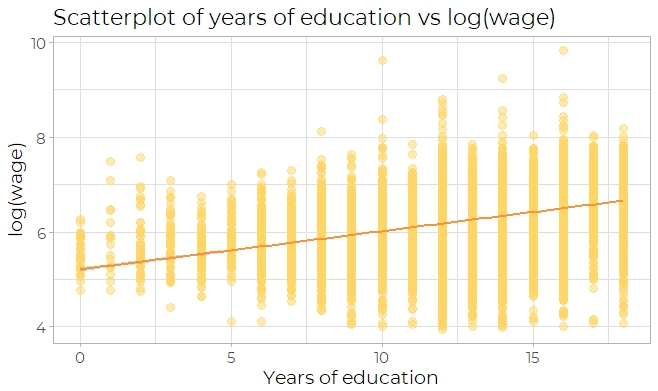
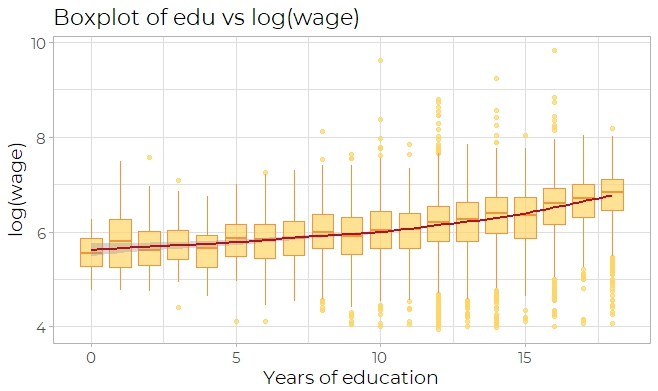
Next, it is suspected that race might have interactions with other explanatory variables. For example, we can try inspecting the interaction between race and education. By plotting the scatter plot of edu versus log(wage) and using the smoother(Fig 3a), we can observe that the African Americans get a lower wage compared to Caucasians and others. The same conclusion can be arrived by inspecting Fig 3b, the scatter plot of edu versus log(wage) using lines. Therefore, an interaction effect between education and race(the product of exp and race) is added to the refined model. After adding the interaction effect, run a R summary to check if the interaction is significant. Here is the interaction statistic taken from the summary output:
Coefficients:
Estimate Std. Error t value Pr(>|t|)
edu:raceother 1.744e-03 5.745e-03 0.304 0.761484
edu:racewhite 4.590e-04 5.069e-03 0.091 0.927852
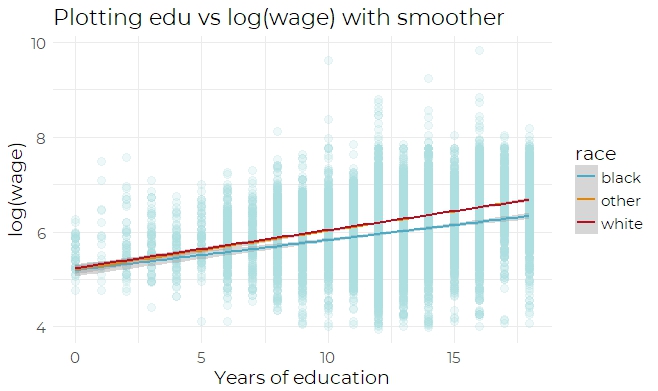
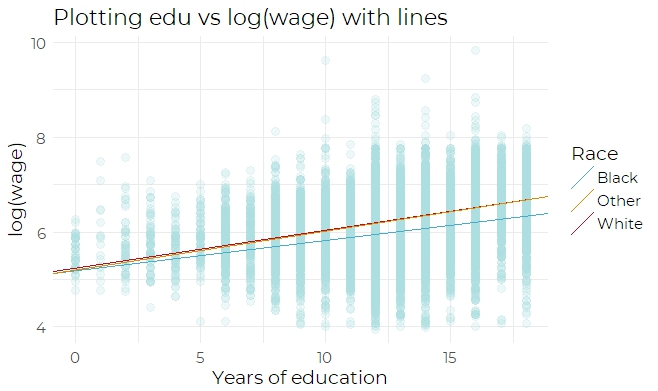
In the above analysis, only the commuting distance and education scatterplots are checked, which is not enough for inspecting the model. Therefore, we plot the scatterplot relates to years of job experience (Fig 4) and the one for number of employees in a company (Fig 5). By inspecting the scatterplot of exp, it is obvious that it follows a curvilinear shape. Therefore, some adjustments should be made to the exp variable (i.e. adding a polynomial form of exp). The scatterplot of emp looks similar to the scatterplot of commuting distance. Therefore, no adjustment is needed for emp variable.


Statistical Model
Summary
Call:
lm(formula = log(wage) ~ edu + edu * race + exp + poly(exp, 3,
raw = T) + city + reg + race + deg + emp, data = train.data)
Residuals:
Min 1Q Median 3Q Max
-2.7969 -0.2915 0.0307 0.3293 3.9577
Coefficients: (1 not defined because of singularities)
Estimate Std. Error t value Pr(>|t|)
(Intercept) 4.035e+00 6.328e-02 63.764 < 2e-16 ***
edu 8.419e-02 4.774e-03 17.637 < 2e-16 ***
raceother 1.849e-01 7.122e-02 2.596 0.009436 **
racewhite 1.906e-01 6.207e-02 3.071 0.002140 **
exp 8.633e-02 2.196e-03 39.309 < 2e-16 ***
poly(exp, 3, raw = T)1 NA NA NA NA
poly(exp, 3, raw = T)2 -2.482e-03 1.078e-04 -23.020 < 2e-16 ***
poly(exp, 3, raw = T)3 2.301e-05 1.501e-06 15.332 < 2e-16 ***
cityyes 1.667e-01 8.465e-03 19.688 < 2e-16 ***
regnortheast 4.329e-02 1.071e-02 4.042 5.31e-05 ***
regsouth -6.638e-02 9.944e-03 -6.675 2.54e-11 ***
regwest -1.388e-02 1.082e-02 -1.283 0.199472
degyes 4.527e-02 1.205e-02 3.757 0.000172 ***
emp 3.995e-04 4.918e-05 8.123 4.82e-16 ***
edu:raceother 4.556e-03 5.521e-03 0.825 0.409206
edu:racewhite 4.388e-03 4.877e-03 0.900 0.368304
---
Signif. codes: 0 ‘***’ 0.001 ‘**’ 0.01 ‘*’ 0.05 ‘.’ 0.1 ‘ ’ 1
Residual standard error: 0.5128 on 19843 degrees of freedom
Multiple R-squared: 0.3486, Adjusted R-squared: 0.3482
F-statistic: 758.6 on 14 and 19843 DF, p-value: < 2.2e-16
Research Question
Question 1
- Step 1) State null hypothesis and alternative hypothesis
H0: race black=race white
HA: race black ≠ race white - Step 2) Check the value of p-value Look at the summary output, the p-value of racewhite is 0.002140, which is lower than 0.05. Therefore, we reject the null hypothesis that the African American males have the same wages as Caucasian males. So African American males have statistically different wages compared to Caucasian males.
Question 2
- Step 1) State the null hypothesis and alternative hypothesis
H0: race black = race white = race other
HA: race black ≠ at least one race - Step 2) Check the value of p-value
Analysis of Variance Table
Response: log(wage)
Df Sum Sq Mean Sq F value Pr(>F)
edu 1 1094.9 1094.90 4164.2243 < 2.2e-16 ***
race 2 88.9 44.43 168.9733 < 2.2e-16 ***
exp 1 977.2 977.22 3716.6565 < 2.2e-16 ***
poly(exp, 3, raw = T) 2 459.8 229.88 874.2892 < 2.2e-16 ***
city 1 118.9 118.90 452.2288 < 2.2e-16 ***
reg 3 31.5 10.49 39.8780 < 2.2e-16 ***
deg 1 3.8 3.83 14.5490 0.000137 ***
emp 1 17.3 17.32 65.8619 5.116e-16 ***
edu:race 2 0.2 0.11 0.4191 0.657622
Residuals 19843 5217.3 0.26
---
Signif. codes: 0 ‘***’ 0.001 ‘**’ 0.01 ‘*’ 0.05 ‘.’ 0.1 ‘ ’ 1
Appendix
a. Model Selection
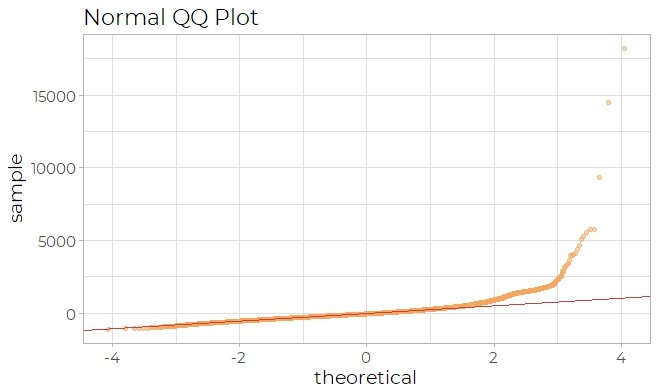
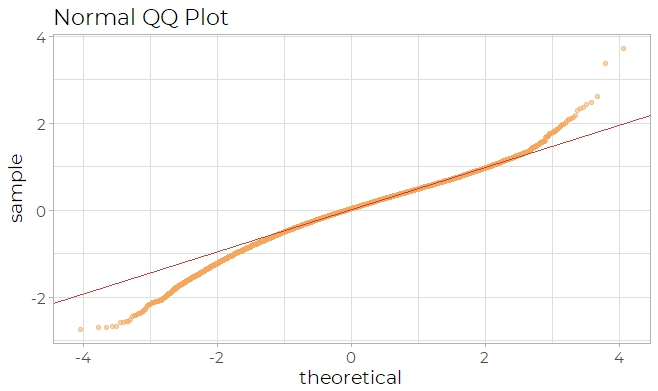
AIC
Best Model:
Df Sum Sq Mean Sq F value Pr(>F)
data.edu 1 1095 1094.9 3820.537 < 2e-16 ***
data.exp 1 981 981.0 3423.246 < 2e-16 ***
data.city 1 99 99.2 346.206 < 2e-16 ***
data.reg 3 46 15.3 53.219 < 2e-16 ***
data.race 2 79 39.5 137.715 < 2e-16 ***
data.deg 1 2 2.2 7.721 0.00546 **
data.emp 1 20 19.9 69.464 < 2e-16 ***
Residuals 19847 5688 0.3
---
Signif. codes: 0 ‘***’ 0.001 ‘**’ 0.01 ‘*’ 0.05 ‘.’ 0.1 ‘ ’ 1
p-value
edu:raceother 0.409206
edu:racewhite 0.368304
b. Diagnostics and Model Validation

The second kind of diagnostic plot used is residual plot, which can be categorized into two section: one is fitted y value versus Studentized residuals, and the other is explanatory variable versus Studentized residuals. The residual plot of y hat versus Studentized residuals (Fig 8a) seems appropriate because the residuals fall within a horizontal band centered around 0.
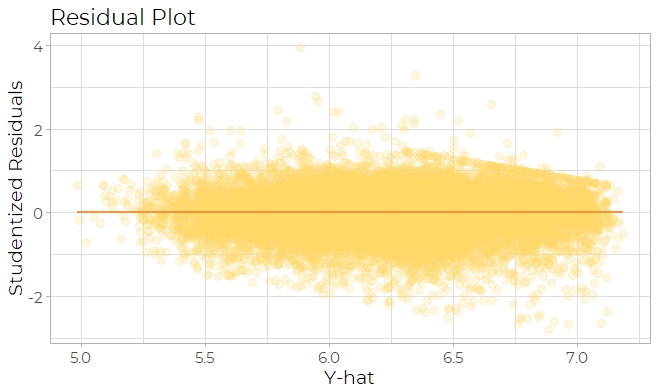
By inspecting the three scatter plots of explanatory variables versus Studentized residuals (Fig 8b), it can be seen that the shape of residuals are in good shape: centered around 0 in a horizontal fashion.
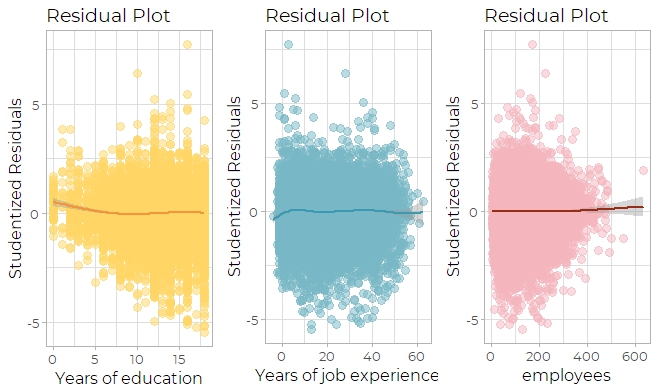
The third diagnostic plot is the box plot (Fig 9), which plots the categorical variables versus the Studentized residuals. Only a few outliers exist, which means this model is appropriate in normality.
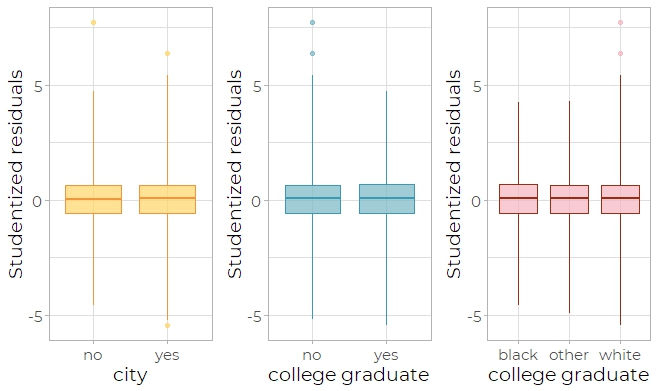
The final diagnostic plot is the line plot (Fig 10), which detects whether there are dependent errors in the model. The line plot does not exhibit any pattern, so it indicates that this model has independent errors, which is appropriate.
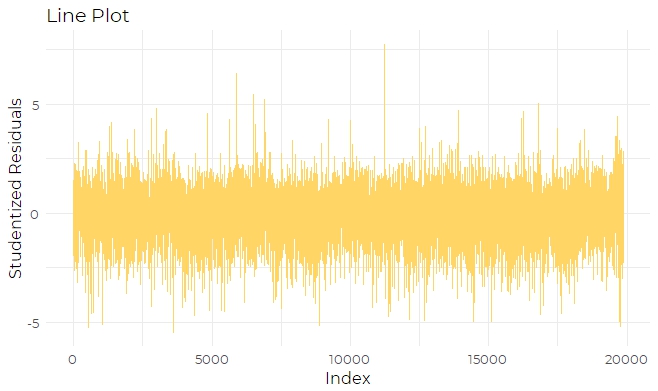
The MSE of the final model is 0.26, and the computed MSPR is 0.263, which is fairly close to MSE, a good indication of the predictive ability of the model.
